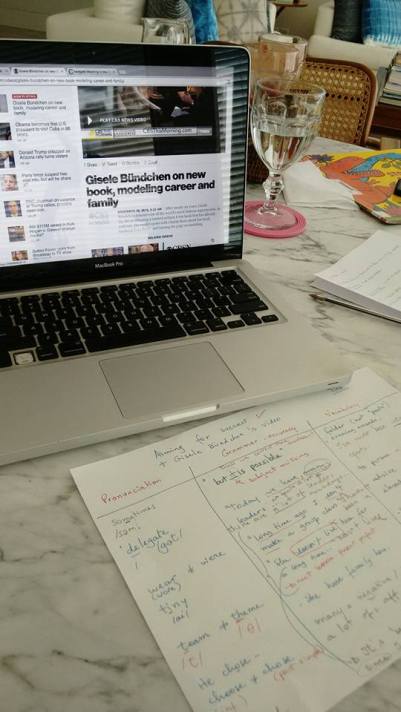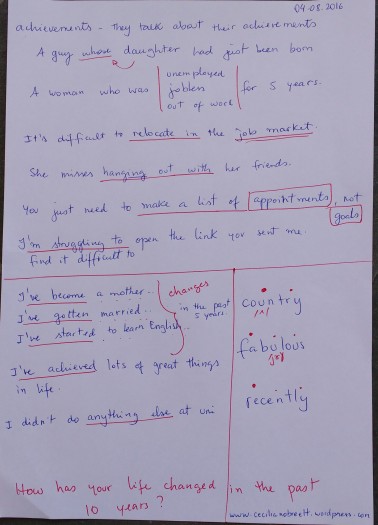
While browsing my endless list of ELT blogs last week, I came across this fantastic post on which Jonathan Ingham demonstrates how he conducts one-to-one lessons when his students just want to chat. He presented a simple, yet extremely useful feedback sheet and ways to give students effective feedback based on it. Genius, witty, I thought. Since then, I’ve been using the same Dogme approach feature with my one-to-one students.
I reckon this feedback sheet works better with A2 students upwards because they tend to produce more spontaneous language output. Say good-bye to the noddings and meaningless praises and grab your blue and bright coloured pen to start off.
I myself am a big fan of writing on paper and I still do it with my online students. The warning : In order to follow this approach, teachers should write during most of the class time. I, personally, tend to write more about lexical items.
In the last 10 minutes of the lesson, I share the feedback sheet with the student and we revisit the language produced, and I might as well “test” it. However, remember to take a picture (and keep it your teaching log or folder) before handing it to the student.
What could you include in your feedback sheet?
-
Separate the sheet into 3 different sessions : Vocabulary, Grammar and Pronunciation
-
Silly, but important : write the date of the lesson. It will help you track their progress.
-
Keep your lesson aim in mind and write the lesson’s topic ( eg. How has your life changed in the past 10 years? or Discuss the problems of public transport in Rio de Janeiro)
-
Write down emerging language from students and underline idioms, language chunks, synonyms, new phrasal verbs, collocations and so on.
-
Instead of writing down student’s mistakes, provided the corrected or more suitable language ( eg : Student’s language with a mistake : “I have difficulty to …” Under the vocabulary session you can write : I find it difficult to focus / I struggle to focus ). Highlight these structures.
-
Use 2 different coloured pens and make it visually attractive.
-
In the pronunciation session, write down phonemic transcriptions and highlight word / sentence stress, as well as other pronunciation features such as connected speech, minimum pairs and so on.
-
Underline key words/ verbs / prepositions that are usually overlooked by students.
-
Did your student use a new piece of language recently learnt ? Were you impressed by it? Register it and draw a smiley face next to it.
-
Make it relevant to the student. You don’t need to write every single utterance.

Why I like this approach
There are several reasons why I find these sheets extremely useful for us teachers.
First, both teachers and students have a record of a learner’s language production, which will then lead to thourough personalised learning experience. Thus, it will provide substantial evidence to better prepare the upcoming lessons and tackle common mistakes and fossilised errors.
Besides that, for me personally, it enhances my listening skills as I do have to pay close attention to what the student is saying or what they are trying to say. It requires excellent note taking skills, a skill quite underused and overlooked nowadays.
Needless to say, we also empower students to speak their minds and, therefore, TTT is lowered.
And then?
Take a picture and email it to your student. You can ask the student to review these notes as homework and you can both revisit it on the following class. You can also suggest that the student should keep it in a folder.
Try it with your student and let me know what you make of it.
Thanks for reading.



Great stuff!
LikeLiked by 1 person
Thanks, Jonny! 🙂
LikeLike
Thanks for sharing all these very useful tips on giving effective feedback to one-to-one students, Cecília! I find it difficult sometimes to keep track on that but I’ve been trying to improve it along the years. Your ideas are worth giving a shot!!!
LikeLiked by 1 person
Hi and sorry for taking so long to reply, Juliana! That won’t happen again!
Yes, I know sometimes we lost the track with our private students – maybe due to a more relaxed atmosphere… I hope this framework works well for you.
LikeLike
Hi Cecilia, thanks for the post!
I have a pretty similar way to keep track of my students’ mistakes and good use of language. However, I mostly show them the most important pieces of language used (both the negative and positive aspects of it).
But maybe taking a picture and sending them later might be even better, so I’ll think about trying this new method since it seems to be more detailed and effective.
Thanks!
LikeLike
That’s great, Danúbia! I actually hand the piece of paper to them and keep the photo to myself 🙂
LikeLike